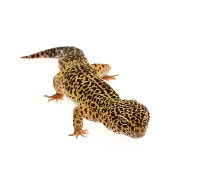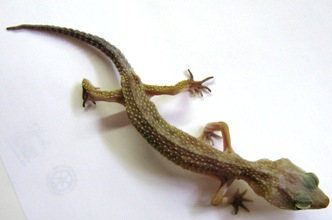Cryptosporidiosis in Leopard Geckos
 Cryptosporidiosis is a common intestinal infection of leopard geckos caused by the one-celled parasite Cryptosporidium varanii (also know in older references as Cryptosporidium saurophilum). Cryptosporidiosis is a very common reason that a leopard gecko will lose weight, and as the tail fat disappears all that remains is a thin boney tail, a condition herpetoculturists often call “stick tail”. Without treatment, a crypto-infected leopard gecko continues to lose weight until it dies. Cryptosporidiosis and other causes of “stick tail” can affect fat-tail geckos, tokay geckos, and other species of geckos with robust tails that can store fat. A similar wasting disease is known in crested geckos and other Rhacodactylus, and many other geckos. Cryptosporidiosis also infects other lizards such as chameleons, gila monsters, and monitor lizards, and likely can infect most lizard species.
Cryptosporidiosis is a common intestinal infection of leopard geckos caused by the one-celled parasite Cryptosporidium varanii (also know in older references as Cryptosporidium saurophilum). Cryptosporidiosis is a very common reason that a leopard gecko will lose weight, and as the tail fat disappears all that remains is a thin boney tail, a condition herpetoculturists often call “stick tail”. Without treatment, a crypto-infected leopard gecko continues to lose weight until it dies. Cryptosporidiosis and other causes of “stick tail” can affect fat-tail geckos, tokay geckos, and other species of geckos with robust tails that can store fat. A similar wasting disease is known in crested geckos and other Rhacodactylus, and many other geckos. Cryptosporidiosis also infects other lizards such as chameleons, gila monsters, and monitor lizards, and likely can infect most lizard species.

A crypto-positive gecko that has lost a lot of weight.

Two extremely skinny crypto-positive leopard geckos. These geckos are critically ill.
A “stick tail” gecko needs a veterinary exam and diagnostic tests to know what is causing the weight loss. Many sick geckos will have more than one underlying problem. Poor husbandry, poor diet, viral infections, bacterial infections, parasitic infections, sand or moss obstruction, kidney disease, and tumors are common causes of weight loss in leopard geckos. However, cryptosporidiosis is the most common reason a leopard gecko loses weight.
The “crypto” organism is passed in the stool. This infective form, called an oocyst, can survive for years. Only steam and a few disinfectants can kill this oocyst. If the oocyst gets swallowed by another gecko, it infects the small intestine where many of the nutrients from food are absorbed. The crypto damages the cells lining the intestine and allows bacterial infections to develop. As this happens, the small intestine can’t absorb food as well and diarrhea develops. As the infection continues, the gecko feels sick, stops eating, and becomes weaker as it loses weight. Death may happen within a few weeks or may take months.
Crypto can be diagnosed from a fecal sample or a swab from the gecko’s cloaca (vent) which is sent to a special diagnostic laboratory to test for Cryptosporidium DNA. At the same time, a veterinarian can check the fecal sample for other parasites, such as flagellated protozoa, which can also cause a poor appetite and weight loss. If this test is negative, then there is some other cause for your gecko’s problems. If the test is positive, then you have some difficult choices to consider.
Your veterinarian may prescribe paromomycin, a drug that can reduce the number of crypto organisms in your gecko. It does not “cure” crypto but helps keep it in low enough numbers for your gecko to recovery. Your gecko may need to be on paromomycin for several weeks to see improvement, and may need to be on it for one or two days a week as a life-long treatment. If your crypto-positive gecko has other infections, such as flagellated protozoa parasites or bacterial infections of its intestines, your veterinarian can offer appropriate medications. If your veterinarian suspects kidney disease or other problems, your gecko may need blood tests or other diagnostic procedures to better assess its outlook.
Not everyone is cut out to provide the lifelong care a crypto-positive gecko (of any species) may need. You need to discuss with your veterinarian the costs of care along with his or her opinion about what the chances are that your pet will have a good quality of life with treatment
If you are going to treat a crypto-positive gecko, you have to commit to providing ideal care:
- A crypto-infect leopard gecko should always be housed by itself until it has regained weight and is doing well. After that, it may be housed with other "healthy" crypto-positive leopard geckos. However, any eggs that are produced are contaminated and any baby geckos that hatch are probably crypto-positive.
- Soak your leopard gecko in 1/8” of shallow lukewarm water for about 15 minutes daily to keep it from becoming dehydrated during treatment. Once a week soaking is fine for a "healthy" crypto-positive leopard gecko.
- Provide a humidity box (a small plastic box packed with damp sphagnum moss) as an extra way to keep your leopard gecko from becoming dehydrated.
- Make sure that at least one end of the cage is around 85-90°F while the other end is 10-20°F cooler but never dropping below 70°F.
- Provide a regular day and night photoperiod -- 10 to 12 hr light and 12 to14 hr dark
- Keep on paper towels to better monitor its feces.
- Give a high quality liquid diet until it starts eating on its own and gaining weight. LaFeber’s Emeraid for Carnivores or Oxbow’s Carnivore Critical Care work well.
- Provide vitamin A, vitamin D3, and calcium supplements. These may be prescribed by your veterinarian during initial treament but can later be provided by dusting the insects with the proper supplements.
- Provide ultraviolet B light (using a ZooMed Reptisun 2.0) for 4 to 8 hr a day to help increase the levels of vitamin D3 in the body. Geckos with intestinal infections can have low levels of vitamin D3 and trouble absorbing calcium. Providing ultraviolet B light may help increase the levels of vitamin D3 allowing a gecko to recover more quickly.
- Give all medications as directed by your veterinarian and follow his or her recommendations for recheck examinations.
- You must prevent spreading crypto to any other lizards by disinfecting tools and other items that come into contact with the gecko. Full strength household ammonia works on crypto but can only be used outside or in a well-ventilated indoor area. Clean off visible dirt and drench the contaminated item with ammonia. Allow it to sit for 15 to 30 minutes and afterward rinsed in fresh water for a few minutes. If you have healthy uninfected geckos or other lizards, you should not handle them after you have been working with the infected gecko.
The more quickly a leopard gecko is diagnosed and received appropriate treatment, the more likely that it will respond to treatment.



